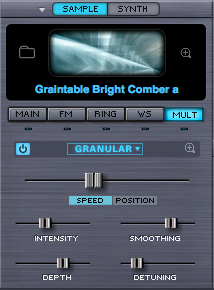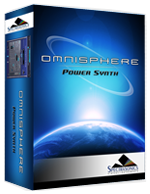EDIT PAGE –
Oscillator Voice Multiplier - Granular (Sample mode only)

Granular synthesis is a powerful method of fragmenting pieces of sound into very small bits of audio called ‘grains’. Since each grain can have its own duration, amplitude and envelope, they can create a layered ‘soundscape’ of overlapping tones. The composer Innas Xenakis first conceptualized Granular synthesis in the 1970s.
Omnisphere contains a fully implemented set of granular controls. While only the most useful controls are presented on the Edit Page, the full set of Granular parameters is available on the Granular Zoom page. Soundsources turned into grains can be manipulated by altering their pitch, duration, envelope and position in the stereo field. Up to eight voices of granularity are available per Layer.
Granular Synthesis is a useful technique for creating a wide variety of sounds, like evolving soundscapes (using Grain and Pitch Controls), time stretching-type sounds (using Speed mode), "freezing" effects (using Position mode), or edgy, gritty glitchiness (using Intensity).
NOTE: Using Granular Synthesis can require a great deal of processing power, so use it wisely.
GRANULAR POWER SWITCH

This turns Granular on and off and it is useful for comparing the granulated sound with the original.
SPEED AND POSITION MODES

There are two exclusive Granular modes: SPEED and POSITION. While other granular parameters work in the same manner regardless of the mode, the slider above the SPEED and POSITION mode selectors controls only the mode selected.
When SPEED mode is selected, the SPEED slider controls the speed at which the grains progress through the sample. As the slider is moved to the right, it slows down the progress of the grains. At .5 (the center point), the grains stop moving through the sample causing a “freezing” effect. Above .5 it reverses and the grains go back towards the start of the sample. SPEED mode is relative: it governs where the next grains will play from relative to the current grains. For example, the grains will be able to move back towards the beginning of the sample only if a key has been depressed long enough to move past the beginning of the sample. Otherwise, you will only hear the beginning portion of sample being granulated. This mode is useful for creating time stretching-type effects, among other applications. The SPEED slider is modulatable.
When POSITION is selected, it is possible to select which portion of the sample is being granulated using the POSITION slider. As an example, you can choose to granulate only the "pluck," or only the decay of a guitar note. The number of zones in a Soundsource determines the maximum range of the POSITION slider. If the Soundsource has more than 12 zones mapped, the range of the POSITION slider slider is 1 second. If it has less than 12 zones, then the POSITION slider's range can be up to 90 seconds. This mode is useful for granulating a specific portion of the sample and for creating “freezing” effects. The POSITION slider is modulatable.
NOTE: Moving the SPEED and POSTION sliders while playing a sample will allow you to add a truly dynamic quality to the sound. Experiment with modulating and MIDI-Learning these parameters. Remember, these modes are exclusive, meaning you can use only one at a time.
In both modes, the results will vary depending on the settings of other Granular parameters, particularly INTENSITY, DEPTH, and SMOOTHING.
INTENSITY

When the sample is sliced into grains, the size of the grains can be altered, which changes the speed and INTENSITY of the effect. When the INTENSITY slider is lower, the grains are longer and there is a slower transition to the next grain. When the INTENSITY slider is higher, the grains are shorter and transition more quickly.
GRAIN Intensity is a Modulatable parameter.
Range 0.000 to 1.000
DEPTH

Moving this slider to the right increases the number of grains which are created from the Soundsource. The higher the number of grains, the higher the demand on the CPU. Excellent results can usually be obtained without using a lot of GRAIN DEPTH, so use it wisely.
Range 0.000 to 1.000
SMOOTHING

Since the grains can vary in pitch and amplitude, the change from grain to grain can be abrupt and jarring. Increasing the value of this slider softens the sharp transitions. Think of SMOOTHING as cross-fading between the grains.
Range 0.000 to 1.000
DETUNING

The grains can be detuned by increasing this control. The higher DETUNING is set, the more variation in pitch will be heard in the grains. This does not affect the pitch of the Soundsource itself, just the grains.
Range 0.000 to 1.000



